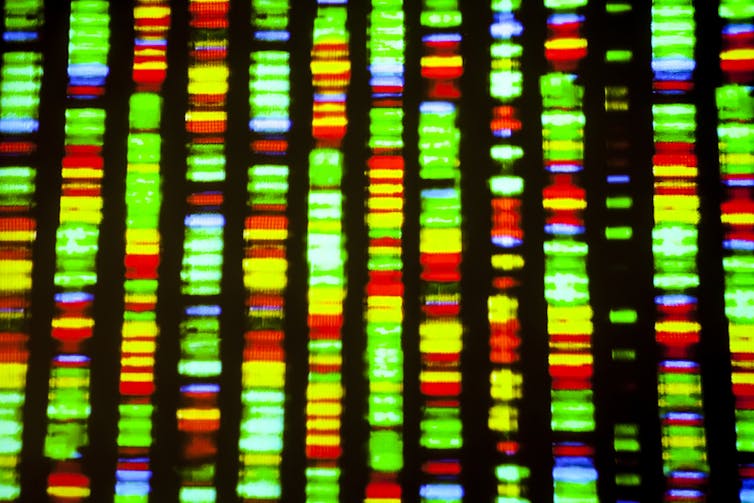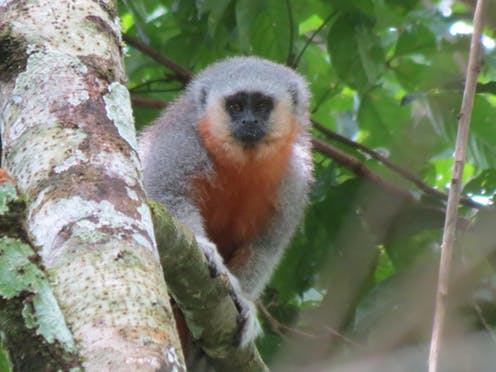Something of a boom in the discovery of new species is taking place right now. It is so significant that some say it is similar to the period of the 18th and 19th centuries when European naturalists ventured into newly discovered lands and brought back an astonishing number of exotic new plants and animals. But how can this be so when species worldwide are disappearing at unprecedented rates?
This is the dichotomy Earth finds itself in as it enters a new chapter in its history – the Anthropocene Epoch, a time marked by the significant global impact that humans are having on the planet’s ecosystems.
What is most unexpected is that such discoveries are not limited to small cryptic organisms (such as insects or parasites) but large animals such as giraffes, elephants, dolphins and even orangutans. In fact, more than 400 species of mammals have been discovered since 1993, and our own order – primates – rank third, with the discovery of more than 50 new species worldwide. Some scientists are even calling it the “new age of discoveries”.
But why are we suddenly finding so many new species after more than a century of believing that there was nothing exciting left to be discovered? People all over the world are now aware that Earth’s biodiversity is in crisis and – for the first time in geopolitical history – the United Nations has recognised that biodiversity is a common concern of humankind. Never before have so many countries officially joined in their efforts to abate the current rate of species loss.
The result is that there is a rekindled interest in biodiversity studies that is leading researchers and conservationists to once again go out on scientific collecting expeditions to underexplored regions of the world, carefully cataloguing the richness of species that is out there.
According to Gerardo Ceballos, of the Universidad Nacional Autonoma de Mexico, and Paul Erlich of Stanford University, nearly 40% of the new mammal species from 1993 to the time of publication of their paper in 2007 resulted from the exploration of new areas, such as in eastern tropical forests of west Africa and the Congo, the Himalaya foothills of northeast India and the Amazonian basin.
Urban expansion and deforestation
The other factor to consider is the rapid urban and rural expansion across many wilderness areas which has made access to these once remote parts of the globe relatively straightforward. This is thanks to large-scale infrastructure development and has resulted in widespread habitat modification. As a result, new species discovered in these areas are often already threatened with extinction by habitat loss and exploitation.
This is what happened to four recently discovered species of titi monkeys from southern and south-western Amazonia. This region was once extremely remote and a place of myth and legend that attracted well known explorers of the early 20th century. Lieutenant Colonel Percy Fawcett led several expeditions to this part of Brazil while searching for the legendary treasure of El Dorado. He and his son never returned from their 1925 voyage.
The US president, Theodore Roosevelt, and Marshal Candido Rondon, together led the famous Scientific Expedition of 1913–14 to navigate the treacherous River of Doubt (now Rio Roosevelt) and map its course. Their trip was beset with disasters culminating with the crushing of their dugout canoes in one of the river’s many rapids.
This region has now become the focus of the Brazilian agricultural industry and holds the highest annual index of deforestation in Brazil. The area is also known as the Brazilian “Arc of Deforestation”, alluding to the crescent-shaped advancing agricultural frontier that is rapidly engulfing the southern edges of the Amazon. With the cutting of the forest and establishment of infrastructure, such as roads, access to this once remote area is no longer difficult, making the discovery of these four new species of titi monkeys almost inevitable.
Splitting in two
But new species are not only being found in the field. Several cases of new species have come from a closer look at well-established species and greater taxonomic scrutiny. The trend of splitting a species in two is largely a result of the now widespread application of modern molecular genetics techniques to the field of taxonomy and systematics.
DNA sequence data can be used to infer evolutionary relationships (phylogeny) among species. It also renders vast amounts of data (the human genome is three billion base pairs long) which means great statistical power. And with the rapid advances in this field it is becoming increasingly cheap to do. The Human Genome Project cost US$2.7 billion. Nowadays, with dozens of available reference genomes, DNA sequence giants, such as Illumina, are promising whole genomes for as little as US$100.

DNA sequence. Shutterstock/Gio.tto
These advances in the field of molecular genetics and genomics, coupled with great advances in supercomputers, mean that whole genomes of organisms can be analysed to produce more and more refined and well resolved phylogenies – showing in many cases cryptic diversity missed by other earlier methods.
Such emerging hidden diversity however, has been met with criticism by some scientist raising the point that we are undergoing a “taxonomic inflation” (an excessive increase in the number of recognised taxa, not because of discovery, but because of changes to how they are defined – such as a sub-species being made into a new species).
This is further aggravated by the use of alternative and less restrictive species concepts, other than the well-established Biological Species Concepts, which defines species in terms of groups of interbreeding natural populations that are reproductively isolated from other such groups.
These less restrictive – concepts, such as the now popular Phylogenetic Species concept , have led to a 50% increase in the number of vertebrate species according to some scientists.
Conservation practitioners, such as IUCN redlist and CITES, are now raising concerns about constantly changing taxonomies and additions. Unstable and rapidly changing taxonomies mean conservation targets are constantly moving and this can hamper conservation. But if we want to save every last kind of organism and allow them to evolve – which is the ultimate goal of conservation – then science should not shy away from learning more about the incredible diversity of life on Earth.



 Bitcoin Defies Gravity Above $93K Despite Missing Retail FOMO – ETF Inflows Return & Whales Accumulate: Buy the Dip to $100K
Bitcoin Defies Gravity Above $93K Despite Missing Retail FOMO – ETF Inflows Return & Whales Accumulate: Buy the Dip to $100K  FDA Adds Fatal Risk Warning to J&J and Legend Biotech’s Carvykti Cancer Therapy
FDA Adds Fatal Risk Warning to J&J and Legend Biotech’s Carvykti Cancer Therapy  Ethereum Ignites: Fusaka Upgrade Unleashes 9× Scalability as ETH Holds Strong Above $3,100 – Bull Run Reloaded
Ethereum Ignites: Fusaka Upgrade Unleashes 9× Scalability as ETH Holds Strong Above $3,100 – Bull Run Reloaded  Is space worth the cost? Accounting experts say its value can’t be found in spreadsheets
Is space worth the cost? Accounting experts say its value can’t be found in spreadsheets  Trump and Merck KGaA Partner to Slash IVF Drug Costs and Expand Fertility Coverage
Trump and Merck KGaA Partner to Slash IVF Drug Costs and Expand Fertility Coverage  Blue Origin’s New Glenn Achieves Breakthrough Success With First NASA Mission
Blue Origin’s New Glenn Achieves Breakthrough Success With First NASA Mission  NASA Cuts Boeing Starliner Missions as SpaceX Pulls Ahead
NASA Cuts Boeing Starliner Missions as SpaceX Pulls Ahead  Cogent Biosciences Soars 120% on Breakthrough Phase 3 Results for Bezuclastinib in GIST Treatment
Cogent Biosciences Soars 120% on Breakthrough Phase 3 Results for Bezuclastinib in GIST Treatment 
































